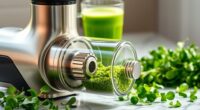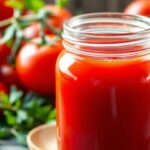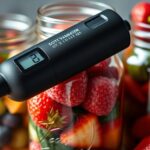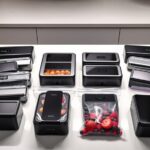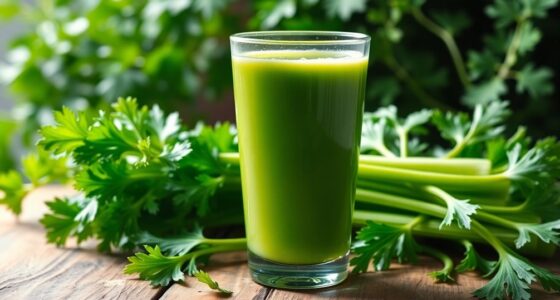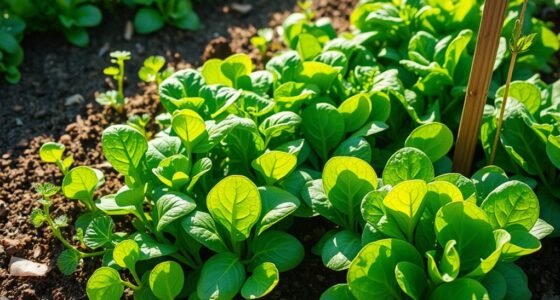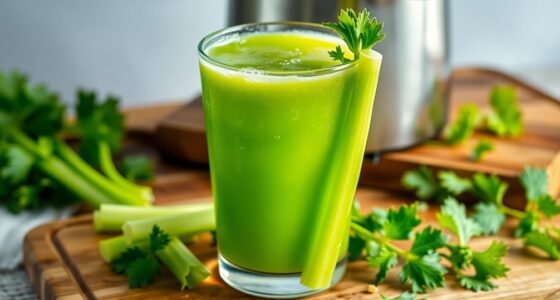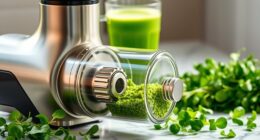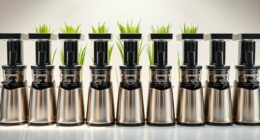To master sous vide, focus on understanding its core principles like precise temperature control and even water circulation, which guarantee perfect doneness. You’ll need essential equipment such as an immersion circulator, vacuum sealer, and heat-safe bags. Learn how to prepare, seal, and set the right temperature for different foods, then follow step-by-step cooking and finishing tips. Avoid common mistakes to achieve consistent results. Exploring simple recipes helps build confidence—keep going to access more expert techniques.
Key Takeaways
- Understand the principles of precise temperature control and water bath cooking for even, consistent results.
- Use essential equipment like an immersion circulator, vacuum sealer, and BPA-free bags for safe, effective cooking.
- Properly prepare and vacuum-seal ingredients to prevent leaks and preserve flavors before cooking.
- Follow best practices for cooking times and searing techniques to enhance flavor, texture, and presentation.
- Avoid common mistakes such as improper sealing or incorrect settings to ensure safety and successful results.
Understanding the Principles of Sous Vide Cooking
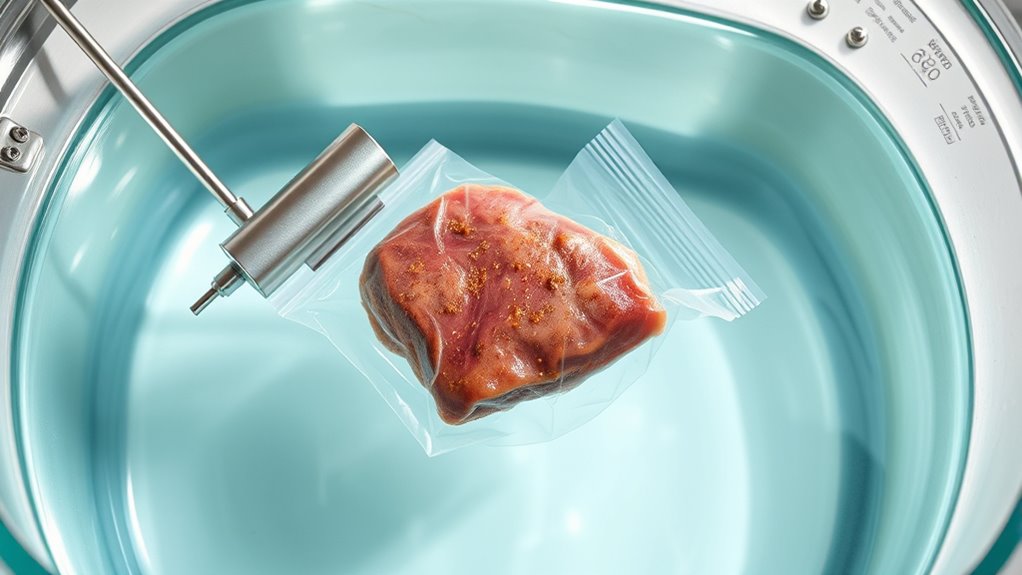
Have you ever wondered how sous vide cooking achieves such perfectly cooked dishes? It all begins with understanding its principles, which draw from molecular gastronomy to manipulate food at a precise temperature. The sous vide history dates back to the 1960s, evolving from scientific experimentation to a popular culinary technique. By vacuum-sealing food and cooking it in a water bath at a consistent, controlled temperature, you guarantee even doneness without overcooking. This method preserves moisture, enhances flavors, and offers unmatched control. Knowing the science behind it helps you grasp why sous vide produces tender, flavorful results every time. This technique’s roots in scientific innovation explain its precision and reliability, making it a game-changer for both professional chefs and home cooks alike. Additionally, understanding cooking equipment like immersion circulators and vacuum sealers can significantly improve your sous vide experience.
Essential Equipment for Beginners
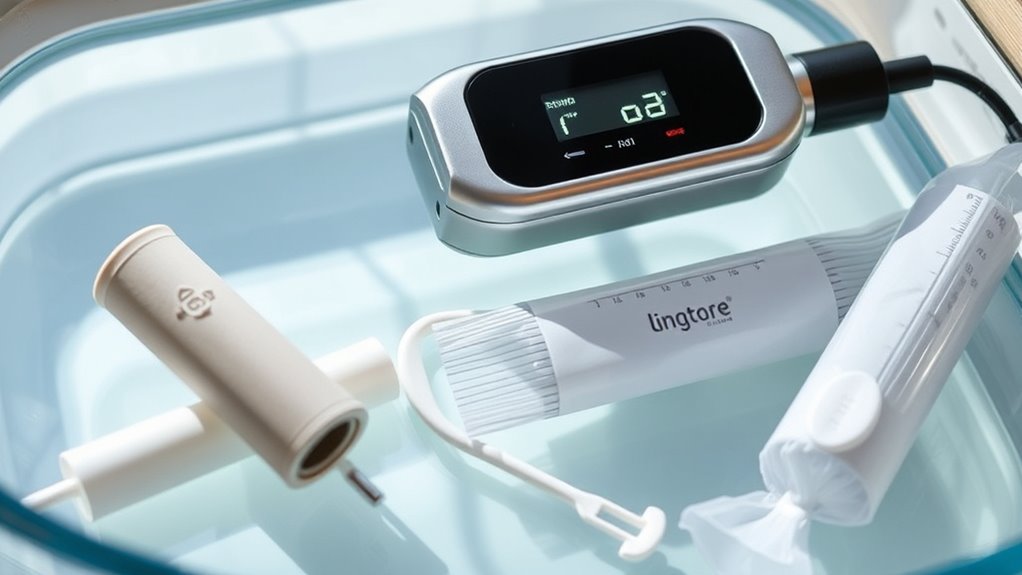
To get started with sous vide, you’ll need a few key pieces of equipment. A reliable immersion circulator, a quality vacuum sealer, and proper containers are essential for precise cooking. Ensuring your devices offer accurate temperature control will help you achieve perfect results every time. Additionally, understanding the evolving landscape of cooking technology can help you stay informed about the latest advancements in sous vide equipment.
Necessary Cooking Devices
Getting started with sous vide cooking requires just a few essential devices. First, you’ll need a reliable immersion circulator, which maintains precise water temperature for consistent results. A large, heat-safe container or pot is also necessary to hold the water and guarantee even heat distribution. These devices help you focus on ingredient prep and kitchen safety, preventing accidents and ensuring food is cooked safely. A digital thermometer can be useful for quick checks, especially when you’re just starting out. While you can get creative, investing in quality equipment ensures safety and accuracy. Proper retail store hours can help you plan your shopping for these devices so you don’t miss out. With these devices, you’ll be ready to master sous vide cooking, making it easier to achieve perfectly cooked meals with confidence.
Quality Vacuum Sealers
A quality vacuum sealer is key to locking in freshness and ensuring your sous vide dishes turn out perfectly. It creates an airtight seal, preventing water from entering and preserving flavors. To keep your sealer functioning well, regular vacuum sealer maintenance is essential—clean the seals and check for wear. When choosing a sealer, consider bag material options; some work better for sous vide, like specially designed heat-safe bags, while others may not provide an effective seal. Investing in a reliable vacuum sealer simplifies the process and improves results. Proper filtration and pump protection help maintain consistent performance and extend the life of your equipment. Remember, a good sealer saves you money in the long run by reducing waste and ensuring consistent, professional-quality dishes. With proper care and the right bags, you’ll enjoy seamless sous vide cooking every time.
Precise Temperature Control
Having precise temperature control is essential for successful sous vide cooking, as it guarantees your food reaches the perfect doneness without overcooking. To achieve this, focus on device calibration to ensure your immersion circulator maintains accurate temperature accuracy. Regularly check and calibrate your device according to the manufacturer’s instructions, as even small deviations can affect results. Investing in a reliable circulator with precise temperature adjustment helps you maintain consistent cooking conditions. Keep in mind that fluctuations in temperature can lead to uneven cooking or undesirable textures. By prioritizing proper device calibration and monitoring temperature accuracy, you can confidently produce perfectly cooked dishes every time. AI security developments highlight the importance of reliable technology in critical applications. Precise temperature control isn’t just a feature—it’s the foundation of successful sous vide cooking.
How to Prepare and Seal Your Food

Choosing the right bag is essential to guarantee your food stays fresh and cooks evenly. You’ll also want to master proper sealing techniques to prevent water leaks and preserve flavors. Once you get these steps right, your sous vide process will be smooth and successful. Incorporating self-watering plant pots principles, such as creating a secure seal to prevent over-saturation, can help ensure consistent results.
Choosing the Right Bag
How do you guarantee your food stays fresh and secure during sous vide cooking? The key is choosing the right bag. Look for bags designed specifically for food storage, which are made from food-grade, BPA-free materials. These bags are durable enough to withstand the heat and water immersion without puncturing or leaking. Avoid regular plastic bags, as they may not be heat-safe or durable enough for sous vide. Seal the bags tightly to prevent water from entering and compromising your food. Investing in high-quality, durable bags ensures your ingredients stay fresh and protected from water contamination, giving you peace of mind that your sous vide process yields perfect results every time. Additionally, selecting bags with proper sealing mechanisms can further enhance food safety and prevent leaks during cooking.
Proper Sealing Techniques
To guarantee your food stays fresh and secure during sous vide, proper sealing is essential. Using the right techniques ensures no water leaks in and that your food stays fresh. Start by choosing the best bag for your needs—look for durable, BPA-free options suited for vacuum sealing. When vacuum sealing, remove as much air as possible to prevent floating and spoilage. Use these tips:
| Step | Action | Tips |
|---|---|---|
| Bag selection | Pick high-quality, food-grade bags | Ensure bags are BPA-free and thick enough |
| Filling | Place food flat for even seal | Avoid overfilling |
| Vacuum sealing | Use a vacuum sealer | Keep the seal straight and tight |
| Final check | Inspect for leaks | Test seal by gently tugging |
Proper sealing makes all the difference in achieving perfect sous vide results. Additionally, understanding Pimple Patch technology can help when dealing with skin blemishes after long cooking sessions or in your skincare routine.
Setting the Right Temperature and Time
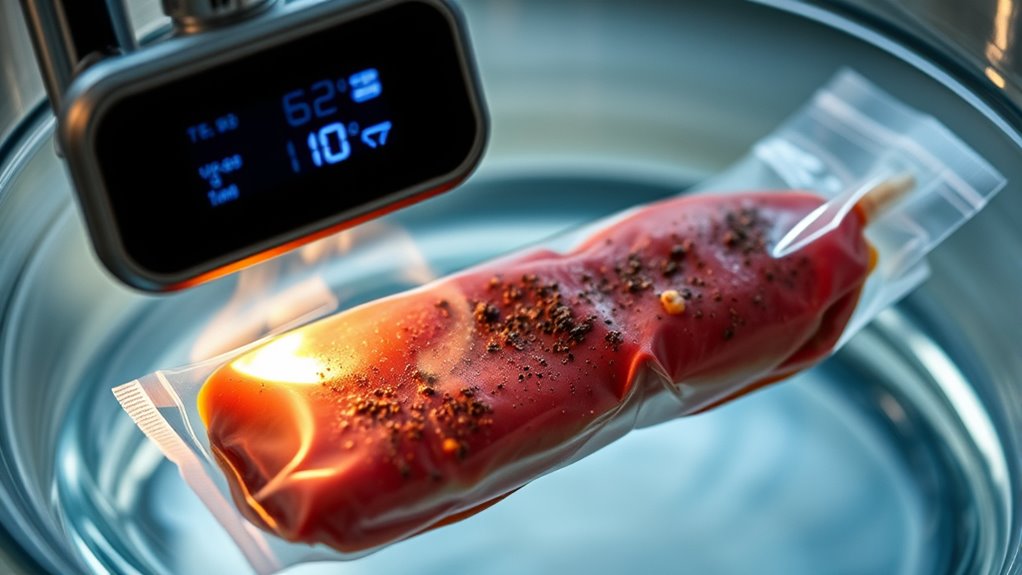
Getting the temperature and time right is essential for achieving perfectly cooked sous vide dishes. Accurate temperature control guarantees your food reaches the desired level of doneness, while timing precision ensures it doesn’t overcook or undercook. To set the right temperature, consult trusted recipes or guidelines for your specific ingredient, adjusting based on your preferred doneness. Use your sous vide device’s thermometer for temperature accuracy, and double-check settings before starting. For time, consider the recommended cooking duration, but remember that longer cook times won’t harm most foods—they may even improve tenderness. Keep in mind that consistent temperature and precise timing are key to predictable, professional results, making your sous vide cooking experience straightforward and satisfying. Additionally, understanding the importance of special occasions can help you plan your cooking schedule around celebrations or meaningful events.
The Cooking Process Step-by-Step

Once your ingredients are prepared and sealed in a vacuum bag, the next step is to set up your sous vide device and immerse the bag in the water bath. Ensure the water level is correct and the device is plugged in. Set the precise temperature based on your recipe, which allows the flavors to infuse evenly and thoroughly. As the water circulates, it gently cooks your food, promoting flavor infusion without overcooking. This slow, controlled process also enhances texture, making meats tender and vegetables perfectly soft. Keep the bag fully submerged, using a weight if necessary, to maintain even contact with the water. Once the cooking time is complete, you’ll be ready for the final touches, but your primary goal here is accurate temperature control for precise cooking and ideal results.
Finishing Touches and Serving Tips
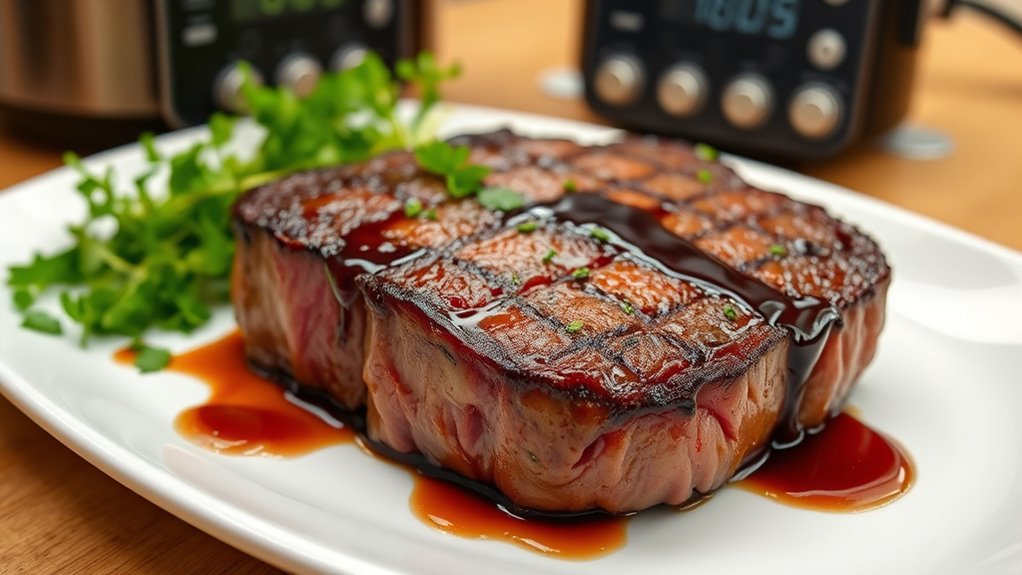
After your sous vide cooking is complete, the next step is to focus on finishing touches and presentation. Proper plating presentation not only makes your dish look appealing but also enhances the overall dining experience. Pat your meat or vegetables dry to ensure a good sear, which boosts flavor enhancement and adds visual appeal. Use a hot skillet or grill to develop a flavorful crust, and consider adding fresh herbs or a drizzle of sauce for extra vibrancy. When plating, arrange your food neatly, paying attention to color contrast and symmetry. This attention to detail elevates your dish’s appearance and shows care in preparation. Remember, a well-presented plate invites you to enjoy your delicious, perfectly cooked sous vide meal even more.
Common Mistakes to Avoid

One common mistake is not properly sealing the bags, which can lead to water leaks and uneven cooking. This often results in overcooking mistakes or ruined food. To avoid this, double-check the seals before submerging. Here are four other mistakes to watch out for:
Avoid water leaks and uneven cooking by double-checking bag seals before submerging.
- Overcooking your food by exceeding recommended times
- Using the wrong bag material, which can compromise proper sealing
- Not setting the correct temperature, risking under or overcooking
- Submerging bags improperly, allowing water to enter and spoil the food
Being mindful of these pitfalls helps ensure your sous vide experience is successful and delicious. Proper sealing and precise timing are key to avoiding common mistakes and getting the best results every time.
Exploring Simple Recipes to Get Started
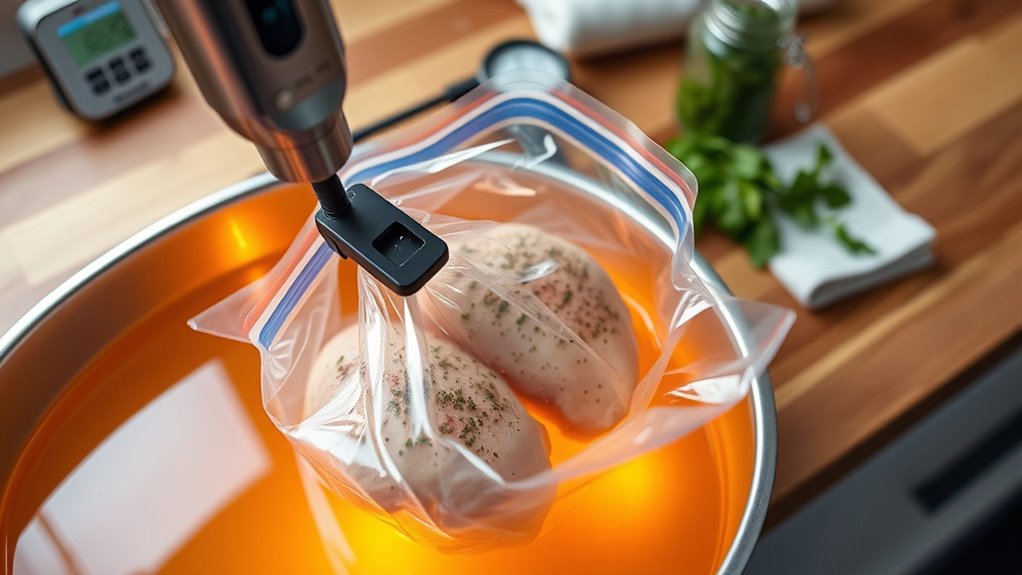
Getting started with sous vide is easier than you might think, especially when you choose simple recipes that don’t require complicated techniques or ingredients. Start with basic proteins like chicken breasts, steaks, or eggs, which cook beautifully and are forgiving for beginners. These recipes allow you to explore flavor infusions by adding herbs, garlic, or spices directly into the bag, enhancing taste effortlessly. As you gain confidence, you can experiment with recipe variations, adjusting seasoning levels or cooking times to suit your preferences. Simple dishes help you understand the process without overwhelm, making sous vide approachable and fun. Once comfortable, you’ll find countless ways to customize your meals, revealing new flavors and textures with minimal effort.
Frequently Asked Questions
Can I Use a Regular Kitchen Thermometer for Sous Vide?
You can use a regular kitchen thermometer for sous vide, but keep in mind that thermometer accuracy varies. A standard thermometer might not provide the precise temperature control needed for perfect results. For better consistency, consider alternative temperature devices like a digital probe or an immersion circulator with built-in sensors. These tools guarantee accurate readings, helping you achieve those ideal, evenly cooked textures without guesswork.
How Do I Store Sous Vide Cooked Leftovers Safely?
To store sous vide cooked leftovers safely, you should first chill them quickly by placing the food in airtight storage containers and refrigerating within two hours of cooking. Use food safety guidelines to prevent bacterial growth, and guarantee your containers are leak-proof and labeled with the date. When reheating, do so thoroughly, and consume the leftovers within 3-4 days for ideal freshness and safety.
Is It Necessary to Vacuum Seal Food for Sous Vide?
You don’t always need to vacuum seal food for sous vide, but it’s highly recommended for ideal food preservation. Vacuum sealing removes air, preventing bacteria growth and freezer burn, and ensures even cooking. If you don’t have a vacuum sealer, using zip-top bags with the water displacement method works well. Ultimately, vacuum sealing helps keep your food fresh longer and enhances sous vide results, making it a smart investment for better food preservation.
How Long Can Food Be Safely Kept After Sous Vide Cooking?
You can safely store food after sous vide cooking for up to 1-2 weeks if you refrigerate it promptly at or below 40°F. For longer storage, freezing is recommended, which extends safety up to 3-6 months. Always prioritize food safety by keeping the storage duration within recommended limits and reheat thoroughly before eating. Proper storage helps maintain flavor, texture, and safety after your sous vide session.
Can I Sous Vide Multiple Ingredients at Once?
Yes, you can sous vide multiple ingredients at once, but you need to be strategic. Imagine the perfect batch cooking session where ingredient layering ensures even cooking and flavors meld beautifully. Just avoid overcrowding the bag, which can cause uneven heat transfer. Use individual bags or compartments to separate ingredients, and keep the water circulating well. This way, you get perfectly cooked, flavorful results every time.
Conclusion
Now that you’ve got the basics down, you’re well on your way to mastering sous vide. With a little practice, you’ll find it’s much easier than it seems and opens up a world of delicious possibilities. Don’t worry if things aren’t perfect at first—every chef has a few surprises. Keep experimenting, enjoy the process, and soon you’ll be surprising yourself with perfectly cooked dishes every time. Happy cooking!
Susannah expertise lies in researching and compiling evidence-based content on juicing, nutrition, and overall health. She is committed to ensuring that The Juicery World offers accurate, up-to-date, and trustworthy information to empower readers to take control of their health. Susannah’s goal is to inspire individuals to embrace juicing as a way to nourish their bodies and live their best lives.


